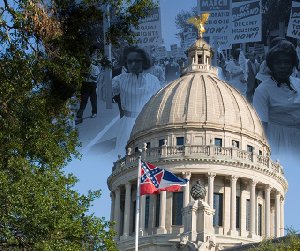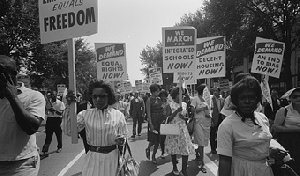One hundred and fifty years after Confederate artillery fired on Fort Sumter, S.C., and the Civil War began, reminders of the conflict that divided a nation remain fresh.
Some see them any given Sunday morning when black Christians and white Christians gather for worship—most often separately.
 |
Historians continue to debate causes of the Civil War—the conflict between an agrarian-based and industrial-based economy, strong central government versus the autonomy of states, and rapid growth as opposed to maintenance of an established way of life. But slavery topped the list, along with related issues such as expansion of slavery into new territories and growth of an abolitionist movement.
“Had it not been for the institution of slavery, there would not have been a Civil War,” said Pamela Smoot, who teaches history and African-American studies at Southern Illinois University.
Long after slavery ended, attitudes that allowed it to exist endured. The United States continues to feel the Civil War’s impact a century and a half after the first shots were fired because the nation in general, and Baptist Christians in particular, have failed to deal with racism, an African-American Texas Baptist leader said.
“Wars are always fought because of something else. The Civil War was symptomatic,” said Michael Bell, pastor of Greater St. Stephen First Baptist Church in Fort Worth and president of the African-American Fellowship of Texas. “Race is the lingering issue, and it has not been adequately addressed by the faith community.”
Bell served as president of the Baptist General Convention of Texas in 2005-2006, the first African-American to hold that post. Although he counts many white Baptists as good friends, Bell acknowledged some subjects remain off-limits in conversations across racial lines.
“Race lurks just beneath the surface of so much that we do, but we dance around it. We circumvent the issue rather than address it,” he said. “The faith community has the ability but not the will to deal with it.”
 |
Smoot likewise noted how underlying attitudes about race still affect relationships among black and white Baptists.
“The ongoing effects of the Civil War on the way Baptists in the U.S. relate to each other are the issues of white paternalism, separatism and autonomy as individuals, with regard to congregations and on the denominational level,” she said.
“Of course, race has been and will always be a factor in this relationship, because there are African-American and white Baptists who still have very deep-seated feelings of racial prejudice. While numerous whites are joining African-American Baptists churches particularly in the North, how many African-Americans are affiliating with southern white Baptist congregations? Perhaps this could be another area of exploration.”
Citing While We Run This Race by Nibs Stroupe and Inez Fleming, Bell noted two factors hinder honest communication between races—white Christians tend to deny racism, and African-American Christians often speak one way among themselves and another way around people of a different race.
“Because of that, there is a superficiality about our conversations. We are not willing to talk honestly for fear it may undermine our relationships. As a result, it can never go to a deeper level. It is never a whole relationship,” he said.
“The larger issue of how we relate as human beings of different races lies just outside the scope of our personal relationships. And that prevents us from growing.”
Christians who historically have been divided by race need to move beyond painful pasts and look instead to the common purpose they share, said Mark Croston, who serves as first vice president both of the predominantly white Baptist General Association of Virginia and the historically African-American Virginia Baptist State Convention.
“As far as what happened in the past is concerned, I try not to let that have any impact on what I do or on the future,” said Croston, pastor of East End Baptist Church, an African-American congregation in Suffolk, Va.
Croston, who grew up in Philadelphia, has served in Virginia 23 years. Any institutions or systems designed to separate black and white Christians disappeared long ago, he observed.
While Christians of different races often tend to operate in different spheres, he attributed that primarily to a narrow focus on individual, time-consuming local ministries—not a narrowness of spirit.
“Race relations is just not on the minds of most people. So, we just keep on doing what we are doing,” Croston said.
“It doesn’t come up on our radar as an area in which we need to make progress.”
Smoot agrees—at least up to a point.
“At this particular point, I do not see any specific barriers to racial reconciliation in American religious life today that can be directly traced to the Civil War,” she said.

The Lincoln Window at New York Avenue Presbyterian Church in Washington, D.C., depicts President Abraham Lincoln. (RNS PHOTO/David Jolkovski)
|
Regarding the continuing existence of churches and denominations organized largely along racial lines, Smoot believes several factors must be held in tension. It remains true, as Martin Luther King Jr. once observed, that 11 a.m. on Sunday is the most segregated hour of the week. But to a degree, that reflects differences in preference regarding worship style and a historic desire among African-Americans for autonomy.
“Black religious independence was extremely important to free African-Americans during the antebellum and from the Civil War to the present. It was about having the right to worship freely,” she said.
“Because African-Americans have successfully established their own churches, convention and foreign mission boards, their leadership skills are no longer subjected to the scrutiny of many white religious bodies and leaders who believed that African-Americans could not thrive without white supervision.”
If black Christians and white Christians would take the time and effort to get acquainted with each other at the personal level, the kingdom of God would benefit, Croston noted.
“When you get to know people, it breaks down the barriers that keep us apart,” he said.
Croston, a past president of the National African-American Fellowship of the Southern Baptist Convention, believes black Baptists and white Baptists can learn from the different facets of the gospel message each typically has emphasized.
“I love the Southern Baptist Convention’s unwavering focus on missions and evangelism. That has been the great strength of the convention,” he said.
African-American churches emphasize another aspect of Christ’s command—to love people and meet needs wherever they exist, he added.
“For us, it’s not an issue of other people, but rather an issue of all our people. There is something about having been left out, forced out and disenfranchised that makes you sensitive to hurting people anywhere in the world.”
Race remains the prism through which black and white Americans—whether Christians or not—view reality. They tend to see any national crisis from different race-based perspectives, Bell asserted.
“We operate out of a hermeneutic of suspicion,” Bell said. “Our interests don’t converge. … Part of what in-forms our relationships is a lack of trust.”
While Bell does not see significant movement toward making race relations a front-burner issue in Baptist life, he remains cautiously hopeful, based on the interest the topic seems to generate. He noted that when he has lectured at Baptist colleges, students packed the sessions and listened eagerly when the topic turned to race.
“Among the ashes of our relationships, that’s the spark, the ember of hope,” he said. “There are some Christians among whom there is a ‘want to’ about improving race relations. There are Baptists who want somebody to start the conversation. But change is difficult.”
Smoot sees a good example of racial harmony dating back about 90 years, with black and white Baptist women leading the way. She points specifically to the Women’s Convention, an auxiliary to the National Baptist Convention U.S.A., Inc., and the Woman’s Missionary Union of the Southern Baptist Convention.
“They have attended and been speakers at each other’s conferences since the 1920s to reconcile past racist behaviors, shared Baptist literature, provided scholarships for girls, initiated fundraisers for various projects and planned joint activities related to the work of the Baptist denomination,” she said. “If these women were successful in their efforts at reconciliation decades ago, there is no doubt that racial reconciliation is possible.”
Even so, Christians often prefer vague platitudes about love and unity to the hard work of relationship building, Bell noted.
“Christ has the ability to change us. We know God shows no partiality. That’s what we preach. We know we are one in Christ. That’s what we say we believe,” Bell said.
“Too often, we are satisfied with the rhetoric, but the reality is different. We like the vision of oneness, but there is a hesitancy on our part to advocate for change and to move forward.”

